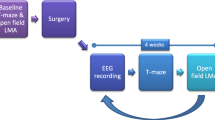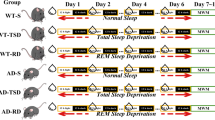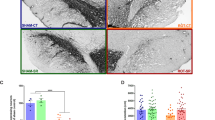Abstract
Parkinson’s disease (PD) is a multifaceted disease in which environmental variables combined with genetic predisposition cause dopaminergic (DAergic) neuron loss in the substantia nigra pars compacta. The mutation of leucine-rich repeat kinase 2 (Lrrk2) is the most common autosomal dominant mutation in PD, and it has also been reported in sporadic cases. A growing body of research suggests that circadian rhythm disruption, particularly sleep-wake abnormality, is common during the early phase of PD. Our present study aimed to evaluate the impact of sleep deprivation (SD) on motor ability, sleep performance, and PD pathologies in Lrrk2G2019S transgenic mice. After two months of SD, Lrrk2G2019S mice at 12 months of age showed an exacerbated PD-like phenotype with motor deficits, a reduced striatal DA level, degenerated DAergic neurons, and altered sleep structure and biological rhythm accompanied by the decreased protein expression level of circadian locomotor output cycles kaput Lrrk2 gene in the brain. All these changes persisted and were even more evident in 18-month-old mice after 6 months of follow-up. Moreover, a significant increase in α-synuclein aggregation was found in SD-treated transgenic mice at 18 months of age. Taken together, our findings indicate that sleep abnormalities, as a risk factor, may contribute to the pathogenesis and progression of PD. Early detection of sleep disorders and improvement of sleep quality may help to delay disease progression and provide long-term clinical benefits.








Similar content being viewed by others
References
Hirtz D, Thurman DJ, Gwinn-Hardy K, Mohamed M, Chaudhuri AR, Zalutsky R. How common are the “common” neurologic disorders? Neurology 2007, 68: 326–337.
Kalia LV, Lang AE. Parkinson’s disease. Lancet 2015, 386: 896–912.
Schapira AHV, Chaudhuri KR, Jenner P. Non-motor features of Parkinson disease. Nat Rev Neurosci 2017, 18: 435–450.
Li S, Jia C, Li T, Le W. Hot topics in recent Parkinson’s disease research: Where we are and where we should go. Neurosci Bull 2021, 37: 1735–1744.
Huang X, Ng SY, Chia NS, Setiawan F, Tay KY, Au WL. Non-motor symptoms in early Parkinson’s disease with different motor subtypes and their associations with quality of life. Eur J Neurol 2019, 26: 400–406.
Seppi K, Chaudhuri KR, Coelho M, Fox SH, Katzenschlager R, Lloret SP, et al. Update on treatments for nonmotor symptoms of Parkinson’s disease-an evidence-based medicine review. Mov Disord 2019, 34: 180–198.
Davies P, Hinkle KM, Sukar NN, Sepulveda B, Mesias R, Serrano G, et al. Comprehensive characterization and optimization of anti-LRRK2 (leucine-rich repeat kinase 2) monoclonal antibodies. Biochem J 2013, 453: 101–113.
Benson DL, Matikainen-Ankney BA, Hussein A, Huntley GW. Functional and behavioral consequences of Parkinson’s disease-associated LRRK2- G2019S mutation. Biochem Soc Trans 2018, 46: 1697–1705.
Ascherio A, Schwarzschild MA. The epidemiology of Parkinson’s disease: Risk factors and prevention. Lancet Neurol 2016, 15: 1257–1272.
Louter M, Aarden WC, Lion J, Bloem BR, Overeem S. Recognition and diagnosis of sleep disorders in Parkinson’s disease. J Neurol 2012, 259: 2031–2040.
Pont-Sunyer C, Hotter A, Gaig C, Seppi K, Compta Y, Katzenschlager R, et al. The onset of nonmotor symptoms in Parkinson’s disease (the ONSET PD study). Mov Disord 2015, 30: 229–237.
Lin CH, Lin JW, Liu YC, Chang CH, Wu RM. Risk of Parkinson’s disease following anxiety disorders: A nationwide population-based cohort study. Eur J Neurol 2015, 22: 1280–1287.
Reijnders JS, Ehrt U, Weber WE, Aarsland D, Leentjens AF. A systematic review of prevalence studies of depression in Parkinson's disease. Mov Disord 2008, 23: 183–189;quiz313.
Patke A, Young MW, Axelrod S. Molecular mechanisms and physiological importance of circadian rhythms. Nat Rev Mol Cell Biol 2020, 21: 67–84.
Li S, Wang Y, Wang F, Hu LF, Liu CF. A new perspective for Parkinson’s disease: Circadian rhythm. Neurosci Bull 2017, 33: 62–72.
Walker WH 2nd, Walton JC, DeVries AC, Nelson RJ. Circadian rhythm disruption and mental health. Transl Psychiatry 2020, 10: 28.
Xiao Q, Yang S, Le W. G2019S LRRK2 and aging confer susceptibility to proteasome inhibitor-induced neurotoxicity in nigrostriatal dopaminergic system. J Neural Transm (Vienna) 2015, 122: 1645–1657.
Qiu H, Zhong R, Liu H, Zhang F, Li S, Le W. Chronic sleep deprivation exacerbates learning-memory disability and Alzheimer’s disease-like pathologies in AβPP(swe)/PS1(ΔE9) mice. J Alzheimers Dis 2016, 50: 669–685.
Zhang F, Zhong R, Li S, Fu Z, Wang R, Wang T, et al. Alteration in sleep architecture and electroencephalogram as an early sign of Alzheimer’s disease preceding the disease pathology and cognitive decline. Alzheimers Dement 2019, 15: 590–597.
Dong J, Liu X, Wang Y, Cai H, Le W. Nurr1Cd11bcre conditional knockout mice display inflammatory injury to nigrostriatal dopaminergic neurons. Glia 2020, 68: 2057–2069.
Chu Y, Kordower JH. Age-associated increases of α-synuclein in monkeys and humans are associated with nigrostriatal dopamine depletion: Is this the target for Parkinson’s disease? Neurobiol Dis 2007, 25: 134–149.
Le WD. Inauguration of a unique journal Ageing and Neurodegenerative Diseases: A new beginning seeking cures for age-related neurodegenerative diseases. Ageing Neurodegener Dis 2021, 1: 1.
Blauwendraat C, Heilbron K, Vallerga CL, Bandres-Ciga S, von Coelln R, Pihlstrøm L, et al. Parkinson’s disease age at onset genome-wide association study: Defining heritability, genetic loci, and α-synuclein mechanisms. Mov Disord 2019, 34: 866–875.
Carmichael K, Sullivan B, Lopez E, Sun L, Cai H. Diverse midbrain dopaminergic neuron subtypes and implications for complex clinical symptoms of Parkinson's disease. Ageing Neurodegener Dis 2021, 1: https://doi.org/10.20517/and.2021.07.
Marras C, Beck JC, Bower JH, Roberts E, Ritz B, Ross GW, et al. Prevalence of Parkinson’s disease across North America. NPJ Parkinsons Dis 2018, 4: 21.
Vandekerckhove M, Cluydts R. The emotional brain and sleep: An intimate relationship. Sleep Med Rev 2010, 14: 219–226.
Nishijima H, Tomiyama M. What mechanisms are responsible for the reuptake of levodopa-derived dopamine in parkinsonian striatum? Front Neurosci 2016, 10: 575.
Zhang F, Niu L, Liu X, Liu Y, Li S, Yu H, et al. Rapid eye movement sleep behavior disorder and neurodegenerative diseases: An update. Aging Dis 2020, 11: 315–326.
Chahine LM, Amara AW, Videnovic A. A systematic review of the literature on disorders of sleep and wakefulness in Parkinson’s disease from 2005 to 2015. Sleep Med Rev 2017, 35: 33–50.
Stefani A, Högl B. Sleep in Parkinson’s disease. Neuropsychopharmacology 2020, 45: 121–128.
Liu Y, Niu L, Liu X, Cheng C, Le W. Recent progress in non-motor features of Parkinson’s disease with a focus on circadian rhythm dysregulation. Neurosci Bull 2021, 37: 1010–1024.
Jin H, Zhang JR, Shen Y, Liu CF. Clinical significance of REM sleep behavior disorders and other non-motor symptoms of Parkinsonism. Neurosci Bull 2017, 33: 576–584.
Kim Y, Kim YE, Park EO, Shin CW, Kim HJ, Jeon B. REM sleep behavior disorder portends poor prognosis in Parkinson’s disease: A systematic review. J Clin Neurosci 2018, 47: 6–13.
Videnovic A, Noble C, Reid KJ, Peng J, Turek FW, Marconi A, et al. Circadian melatonin rhythm and excessive daytime sleepiness in Parkinson disease. JAMA Neurol 2014, 71: 463–469.
Bolitho SJ, Naismith SL, Rajaratnam SM, Grunstein RR, Hodges JR, Terpening Z, et al. Disturbances in melatonin secretion and circadian sleep-wake regulation in Parkinson disease. Sleep Med 2014, 15: 342–347.
Lauretti E, di Meco A, Merali S, Praticò D. Circadian rhythm dysfunction: A novel environmental risk factor for Parkinson’s disease. Mol Psychiatry 2017, 22: 280–286.
Leng Y, Musiek ES, Hu K, Cappuccio FP, Yaffe K. Association between circadian rhythms and neurodegenerative diseases. Lancet Neurol 2019, 18: 307–318.
Hastings MH, Goedert M. Circadian clocks and neurodegenerative diseases: Time to aggregate? Curr Opin Neurobiol 2013, 23: 880–887.
Kudo T, Loh DH, Truong D, Wu Y, Colwell CS. Circadian dysfunction in a mouse model of Parkinson’s disease. Exp Neurol 2011, 232: 66–75.
Videnovic A, Willis GL. Circadian system - A novel diagnostic and therapeutic target in Parkinson’s disease? Mov Disord 2016, 31: 260–269.
Yujnovsky I, Hirayama J, Doi M, Borrelli E, Sassone-Corsi P. Signaling mediated by the dopamine D2 receptor potentiates circadian regulation by CLOCK: BMAL1. Proc Natl Acad Sci U S A 2006, 103: 6386–6391.
Lou F, Li M, Luo X, Ren Y. CLOCK 3111T/C variant correlates with motor fluctuation and sleep disorders in Chinese patients with Parkinson’s disease. Parkinsons Dis 2018, 2018: 4670380.
Shkodina AD, Tan SC, Hasan MM, Abdelgawad M, Chopra H, Bilal M, et al. Roles of clock genes in the pathogenesis of Parkinson’s disease. Ageing Res Rev 2022, 74: 101554.
Li H, Song S, Wang Y, Huang C, Zhang F, Liu J, et al. Low-grade inflammation aggravates rotenone neurotoxicity and disrupts circadian clock gene expression in rats. Neurotox Res 2019, 35: 421–431.
Li H, Fan X, Luo Y, Song S, Liu J, Fan Q. Repeated manganese administration produced abnormal expression of circadian clock genes in the hypothalamus and liver of rats. Neurotoxicology 2017, 62: 39–45.
Chen Z, Xiong ZF, Liu X. Research progress on the interaction between circadian clock and early vascular aging. Exp Gerontol 2021, 146: 111241.
Pick R, He W, Chen CS, Scheiermann C. Time-of-day-dependent trafficking and function of leukocyte subsets. Trends Immunol 2019, 40: 524–537.
Waggoner SN. Circadian rhythms in immunity. Curr Allergy Asthma Rep 2020, 20: 2.
Pacelli C, Rotundo G, Lecce L, Menga M, Bidollari E, Scrima R, et al. Parkin mutation affects clock gene-dependent energy metabolism. Int J Mol Sci 2019, 20: 2772.
Priano L, Bigoni M, Albani G, Sellitti L, Giacomotti E, Picconi R, et al. Sleep microstructure in Parkinson’s disease: Cycling alternating pattern (CAP) as a sensitive marker of early NREM sleep instability. Sleep Med 2019, 61: 57–62.
Margis R, Schönwald SV, Carvalho DZ, Gerhardt GJ, Rieder CR. NREM sleep alpha and sigma activity in Parkinson’s disease: Evidence for conflicting electrophysiological activity? Clin Neurophysiol 2015, 126: 951–958.
Wetter TC, Brunner H, Högl B, Yassouridis A, Trenkwalder C, Friess E. Increased alpha activity in REM sleep in de novo patients with Parkinson’s disease. Mov Disord 2001, 16: 928–933.
Acknowledgments
We thank Liaoning Provincial Center for Clinical Research on Neurological Diseases, the First Affiliated Hospital, and Dalian Medical University for the research infrastructure and support. This work was supported by the National Natural Science Foundation of China (81771521).
Author information
Authors and Affiliations
Corresponding author
Ethics declarations
Conflict of interest
The authors declare that the research was conducted in the absence of any commercial or financial relationships that could be construed as a potential conflict of interest.
Supplementary Information
Below is the link to the electronic supplementary material.
Rights and permissions
About this article
Cite this article
Liu, X., Yu, H., Wang, Y. et al. Altered Motor Performance, Sleep EEG, and Parkinson’s Disease Pathology Induced by Chronic Sleep Deprivation in Lrrk2G2019S Mice. Neurosci. Bull. 38, 1170–1182 (2022). https://doi.org/10.1007/s12264-022-00881-2
Received:
Accepted:
Published:
Issue Date:
DOI: https://doi.org/10.1007/s12264-022-00881-2




